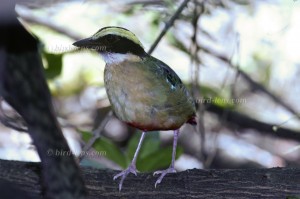The African Pitta (Pitta angolensis) also called Angola Pitta is certainly one of the top prizes for birdwatchers going for Africa.
Some years ago I spent 3 days at the end of the so-called Green (i.e. rainy) Season in the Liwonde National Park. I decided to stay in the Mvuu Lodge. One of the highlights of the area of the lodge and the Mvuu Camp is the irregular appearance of the enigmatic African Pitta (Pitta angolensis). It was the 18th of March and on the morning, at 6:00 all (few) guests of the lodge had booked a trip on foot. The guide was Richard. We rattled the whole area with the scrub vegetation for the Pitta and a Broadbill (Smithornis sp.). Unfortunately in vain. Instead, for example we observed Grey-headed Kingfisher (Halcyon leucocephala), Grey Tit-Flycatcher (Myioparus plumbeus), Cardinal Woodpecker (Dendropicos fuscescens), Broad-tailed Paradise-Whydah (Vidua obtuse), Arrow-marked Babbler (Turdoides jardineii), Cape (Long -billed ) Crombec (Sylvietta rufescens), Chinspot Batis (Batis molitor), Lesser Masked Weaver (Ploceus intermedius) and had nice views of a Green Woodhoopoe (Phoeniculus purpureus).
Later in the morning, I booked a boat tour. The National Park side of the river with some oxbows is very beautiful and productive in terms of birds. I can photograph a beautiful Blue-cheeked Bee-eater (Merops persicus) on its perch. Dito a Winding Cisticola. Quite fast, it is getting hot and very humid. The sun burns like crazy. I was glad – honestly – that I did not invest in the tour two hours later. After that experience, I just wanted to sit down and rest, enjoy the shade on the porch of my chalet. Suddenly Richard was back in the door. “The Pitta is there. Quick, quick!”, he shouted. I pulled back quickly, took the lens 300 f 2,8, a flash and the tripod. Then we started to the Mvuu camp which is located not far away. In the vicinity of the Staff accommodation there was a thicket. I did not see anything. I checked the underfloor of the thicket, crawled on the floor. Ok, yes this is really an African Pitta. Seeing the bird is one thing that already has its own charm. After all, even the boss of Safari Wilderness Tours perfomed a trip recently from Lilongwe to see the pitta. But he was not successful with the bird.
But I also want to take images. To photograph the African Pitta is still a very different thing. I worked hard for one hour and more. I kept changing my positon with my guides support on the edges of the bush. Unfortunately the African Pitta seemed a bit reluctant. Not really shy, but at least it could not be approached easily. I tried to stay under the bush, which was located on a termite mound. After a while laying calm in the heat, I really could take fabulous looks, took pictures and even flash the African Pitta after some time. Finally the Pitta came so close to me that even the 300-lens with its close focus was to big. Really I was very impressed. A thrill experience!
I was there in the Green Season from December to March. This time is one of the prime birding season in Malawi. Summer is the best season to experience avian diversity to the max with visitors like palearctic migrants and even African pitta. The best month is said to be December – if there are abundant rains. I was lucky, as there are years with no sighting of the Angola Pitta in Malawi at all.
Anyone visiting the Liwonde National Park at the time mentioned above is greeted with lush summer scenes of the picturesque Shire River Valley. Large elephant herds and other game species are excellent to observe on the Shire River floodplain and in the woodland areas. The prolific resident birds are bolstered by many summer migrant species Europe and Western Asia. Lake Malawi and Mvuu are both at an altitude of about 400 metres above sea level (asl) and therefore quite warm in the most time of the year.
Accomodation is possible in the Mvuu Camp as well as in the Mvuu Lodge. Mvuu Camp overlooks a broad stretch of the Shire River in the Liwonde National Park. The camp is a mixture of tents and stone and canvas chalets and specially-designed. The view of the Shire River allows observations of Hippos, Crocodiles and the amazing birdlife.
